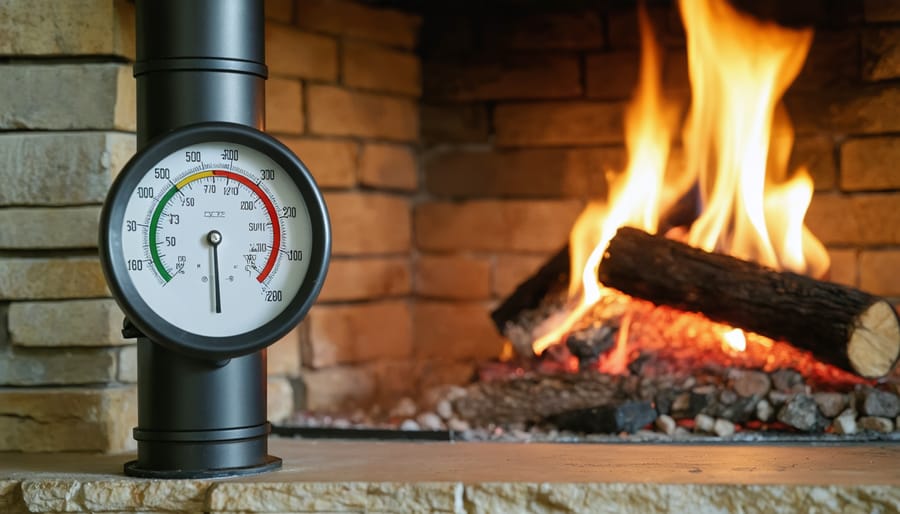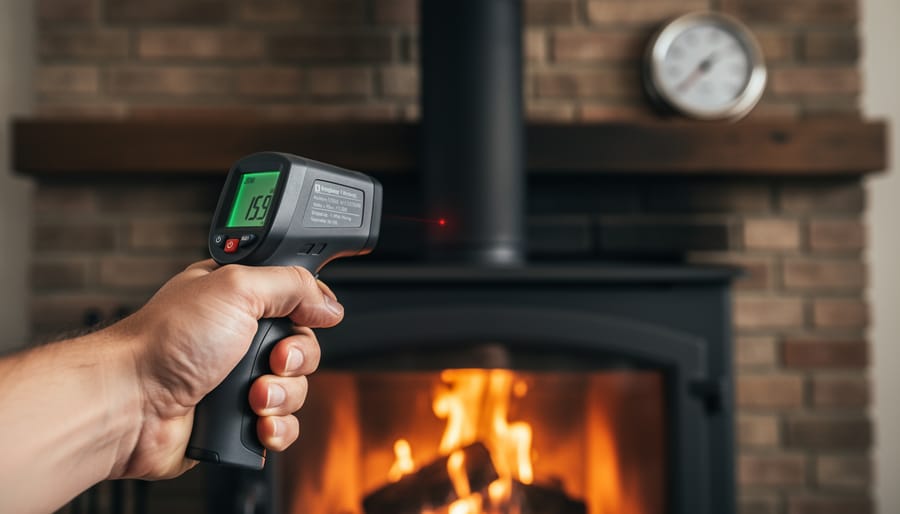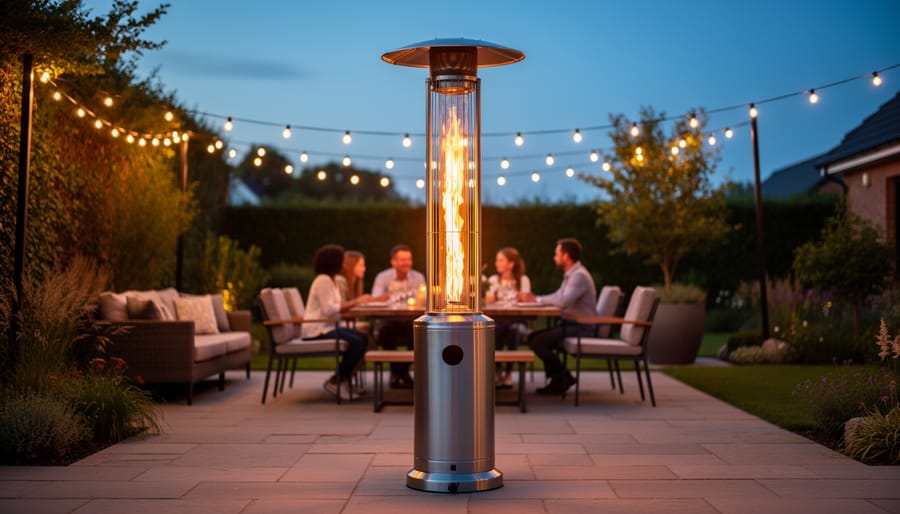**Understanding Temperature Adjustment Hydrometers: Your Guide to Precise Fireplace Monitoring**
Temperature adjustment hydrometers—more accurately called temperature-compensated thermometers or adjustable temperature gauges—eliminate the guesswork in monitoring your fireplace’s heat output. These precision instruments automatically account for ambient temperature variations that cause standard thermometers to give false readings, ensuring you maintain optimal burning conditions for both safety and efficiency.
Your fireplace operates best within specific temperature ranges: too cool and you’ll experience incomplete combustion with excessive creosote buildup; too hot and you risk damaging your firebox or chimney liner. A quality temperature-compensated gauge mounted on your stovepipe or fireplace surround provides real-time feedback, helping you adjust airflow to maintain that sweet spot between 250-900°F depending on your setup.
Modern homeowners embracing eco-friendly heating solutions particularly benefit from these tools. By maintaining consistent, appropriate temperatures, you’ll burn less wood, produce fewer emissions, and extract maximum heat from every log—transforming your fireplace from an atmospheric accent into a genuinely efficient heating system.
Whether you’re new to wood burning or a seasoned enthusiast, understanding how temperature compensation works empowers you to create the perfect ambiance while protecting your investment and keeping your family safe.
What Is a Temperature Adjustment Hydrometer?
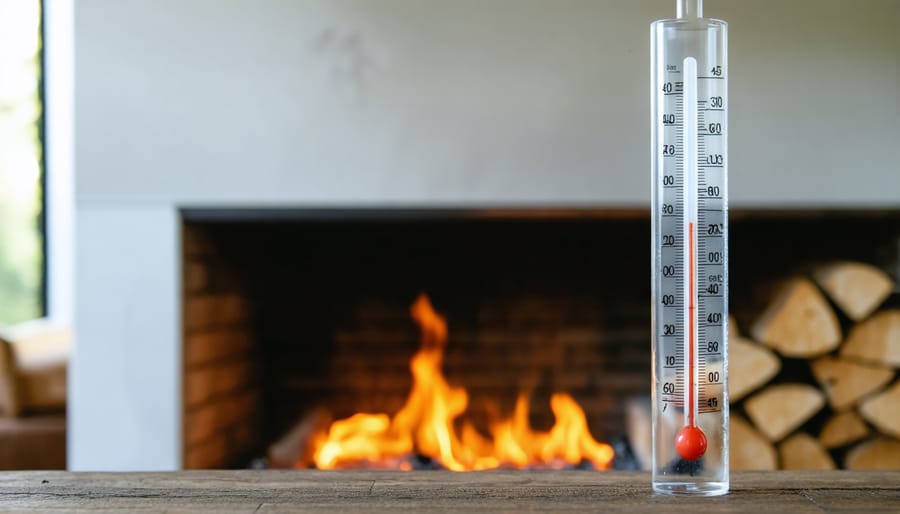
The Science Made Simple
Understanding how a temperature adjustment hydrometer works doesn’t require an engineering degree – think of it as a smart thermometer that accounts for the moisture in your air. Just like how a humid summer day feels hotter than a dry one at the same temperature, the humidity around your fireplace affects temperature readings too.
Here’s the beautiful simplicity: these devices measure both temperature and humidity simultaneously, then automatically adjust the reading to show you what the temperature actually “feels like” in your space. The hydrometer portion detects water vapor in the air, while the thermometer tracks heat levels. When moisture levels are high, the device compensates because humid air conducts heat differently than dry air.
Why does this matter for your fireplace? The area around your hearth creates a unique microclimate. When you’re burning wood, moisture released from the logs increases humidity nearby. Your fireplace also draws in air from other parts of your home, creating temperature variations that simple thermometers miss entirely. Without humidity compensation, you might think your room is warmer or cooler than it truly is, leading to inefficient heating and wasted energy.
A temperature adjustment hydrometer gives you the complete picture of your fireplace’s heating performance, helping you optimize burn times and maintain consistent comfort while keeping your eco-friendly heating solution running at peak efficiency. It’s precision made practical for everyday living.
Why Regular Thermometers Fall Short
Standard thermometers simply weren’t designed with fireplace environments in mind. While they work perfectly fine for checking your outdoor temperature or monitoring your home’s general climate, they struggle when faced with the unique challenges your fireplace creates.
Think about what’s happening around your hearth: intense radiant heat pulsing from burning logs, moisture escaping from wood as it combusts, and constant air movement as warm air rises up the chimney. Traditional mercury or digital thermometers can’t accurately account for these variables simultaneously. They might tell you the air temperature at one specific point, but they miss the bigger picture of how heat, humidity, and airflow interact.
Even infrared thermometers, while excellent for surface temperature readings, don’t measure humidity levels that affect how efficiently your fire burns or how comfortable your room feels. You need a tool that understands the relationship between temperature and moisture—especially important for eco-friendly heating solutions where maximizing wood efficiency matters.
This is where temperature adjustment hydrometers shine, offering the comprehensive environmental monitoring that standard thermometers simply can’t provide for fireplace owners who care about both comfort and efficiency.
When You Actually Need This Advanced Tool
Safety-Conscious Homeowners
When it comes to enjoying your fireplace safely, knowing exactly what’s happening inside your chimney and firebox makes all the difference. A temperature adjustment hydrometer gives you the precision monitoring you need to prevent dangerous situations before they develop.
Overheating is one of the most common yet preventable hazards fireplace owners face. When temperatures climb too high—often beyond 900°F in your flue—you’re entering the danger zone for chimney fires. Creosote, that stubborn byproduct of wood burning, ignites at these extreme temperatures, potentially causing devastating structural damage. With accurate temperature readings at your fingertips, you’ll know exactly when to adjust your damper or reduce your burn rate.
Beyond fire prevention, proper temperature monitoring protects your home’s investment. Excessive heat can crack masonry, warp metal components, and deteriorate chimney liners far faster than normal wear and tear. Think of your hydrometer as an early warning system that helps you maintain that sweet spot—hot enough for efficient, eco-friendly heating, but controlled enough to preserve your fireplace’s integrity for years to come. This peace of mind transforms your fireplace from a potential liability into the cozy, safe gathering place it should be.
Efficiency Enthusiasts
For those who love both a cozy fire and watching their energy bills, a temperature adjustment hydrometer becomes your secret weapon for maximum efficiency. By tracking precise temperature readings, you’ll discover the sweet spot where your fireplace delivers optimal warmth without wasting fuel or sending precious heat straight up the chimney.
Here’s where it gets exciting: when you know your exact combustion temperature, you can adjust airflow and fuel placement to achieve complete, clean burns. This means you’re extracting every BTU possible from each log, reducing fuel costs while minimizing smoke and emissions—a win for both your wallet and the planet. Many enthusiasts report fuel savings of 15-20% once they master temperature-based fire management.
Pairing your hydrometer data with quality equipment like an efficient fireplace grate maximizes airflow and heat distribution. Monitor temperatures during different burn stages to identify when to add fuel, adjust dampers, or let coals settle. You’ll develop an intuitive understanding of your fireplace’s rhythm, creating consistently efficient fires that deliver comfortable warmth without the waste. It’s not just about burning smarter—it’s about enjoying guilt-free comfort knowing you’re treading lightly on the environment.
Choosing the Right Temperature Adjustment Hydrometer for Your Fireplace
Key Features That Actually Matter
When you’re choosing a temperature adjustment hydrometer for monitoring your fireplace or heating system, certain features make all the difference between a tool that truly enhances your home’s comfort and one that collects dust in your toolbox.
**Measurement Range** should be your first consideration. For fireplace applications, you’ll want a device that reads from at least 32°F up to 500°F or higher. This range captures everything from cold startup conditions to the intense heat generated during peak burning, giving you complete visibility into your heating system’s performance.
**Accuracy ratings** separate quality instruments from basic thermometers. Look for models with accuracy within ±2°F or better. This precision matters when you’re fine-tuning your fireplace’s air intake or determining optimal burning temperatures for efficiency and reduced emissions—a win for both your wallet and the environment.
**Response time** is often overlooked but critically important. The best temperature adjustment hydrometers update readings within 2-3 seconds, allowing you to make real-time adjustments to your fire. Slower devices leave you guessing, potentially wasting fuel or creating unsafe conditions.
**Durability in high-heat environments** cannot be compromised. Seek instruments with heat-resistant casings, protective shields, and sensors rated for prolonged exposure to elevated temperatures. Quality construction means your investment lasts through countless cozy evenings by the fire, season after season. Consider models with replaceable probes—they offer better long-term value and reduce waste, aligning with eco-conscious home management practices.
Analog vs. Digital Models
When choosing a temperature adjustment hydrometer for your fireplace, you’ll encounter both traditional analog and modern digital models, each bringing distinct advantages to your hearth.
Analog hydrometers offer time-tested reliability without batteries or power sources. These classic instruments are built to last decades, featuring simple mechanical designs that won’t fail during power outages. They’re incredibly affordable and provide at-a-glance readings perfect for quick temperature checks. However, they require manual calibration and can be harder to read in dim lighting—a common challenge near cozy firesides.
Digital models excel in precision and convenience, often displaying readings within 0.1-degree accuracy. Many feature backlit screens, memory functions, and data logging capabilities that help you track temperature patterns over time. Some advanced versions even integrate with smart temperature monitoring systems for automated climate control. The trade-off? They need batteries or charging, cost more upfront, and may have shorter lifespans.
For most fireplace enthusiasts, digital models offer better long-term value through enhanced accuracy and features. However, keeping an analog backup ensures you’re never without temperature monitoring capability—especially important for safe, eco-friendly heating practices.
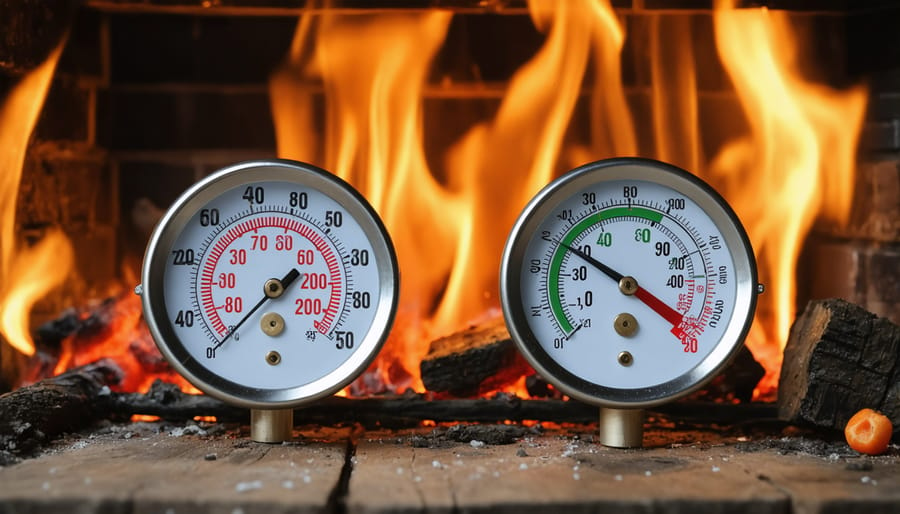
How to Use Your Temperature Adjustment Hydrometer Effectively
Proper Placement for Accurate Readings
Getting accurate temperature readings starts with smart placement of your hydrometer, and this varies depending on your fireplace type. For traditional wood-burning fireplaces, position your hydrometer on the mantel at least 12 inches above the opening, where it can capture the radiant heat without being overwhelmed by direct flames. This sweet spot gives you reliable data about how effectively your fire is warming the room.
Gas fireplaces burn more consistently, so you have flexibility in placement. Mount your hydrometer 18-24 inches to either side of the firebox at mantel height. This positioning captures the steady heat output while avoiding any direct exposure to the glass panels, which can skew readings.
For sleek bioethanol fireplaces—an increasingly popular eco-friendly heating solution—placement requires special attention. Since these units produce gentler, more localized heat, position your hydrometer within 3-4 feet of the flame source, preferably at eye level. This ensures you’re monitoring the actual warmth reaching your living space rather than just ambient room temperature.
Remember, your hydrometer should never be so close that it becomes a safety hazard or experiences temperatures beyond its range. Think of it as finding the perfect seat by your fireplace—close enough to feel the warmth, but comfortable enough to enjoy it safely.

Calibration and Maintenance Tips
Keeping your temperature adjustment hydrometer in peak condition ensures accurate readings that help you maintain optimal fireplace efficiency and home comfort. Think of it like maintaining your ash vacuum—regular care extends its lifespan and performance.
**Simple Cleaning Routine**
After each use, gently wipe your hydrometer with a soft, lint-free cloth to remove dust and residue. Avoid harsh chemicals that might damage the sensors or calibration mechanisms. For digital models, check the battery compartment monthly and replace batteries as needed to prevent corrosion.
**Recalibration Schedule**
Most quality hydrometers benefit from recalibration every 6-12 months, depending on usage frequency. Many models include calibration instructions in their manuals, or you can verify accuracy against a known temperature standard. Store your device in a cool, dry place away from direct sunlight and extreme temperatures when not in use.
**Signs You Need Recalibration**
If readings seem inconsistent or your fireplace isn’t performing as efficiently as usual despite following your routine, it’s time to recalibrate. This simple maintenance step ensures you’re getting reliable data for eco-friendly heating management and optimal home comfort throughout the seasons.
Real-World Benefits: What Accurate Temperature Monitoring Changes
When you invest in a temperature adjustment hydrometer for your fireplace, you’re not just buying a gadget—you’re unlocking measurable improvements in how your fireplace performs and feels in your home.
Let’s start with your wallet. Accurate temperature monitoring helps you burn fuel more efficiently, whether you’re using wood, pellets, or gas. By understanding the true temperature inside your firebox, you can avoid over-firing (which wastes fuel and creates excessive heat) or under-firing (which produces incomplete combustion and wasted energy). Many homeowners report fuel savings of 15-20% simply by maintaining optimal temperature ranges based on accurate readings. That’s money back in your pocket season after season.
Then there’s the ambiance factor. Your fireplace isn’t just about heat—it’s a lifestyle element that creates mood and comfort. With precise temperature data, you can fine-tune your fire to achieve that perfect glow and warmth level for cozy evenings or entertaining guests. No more guessing whether to add another log or adjust the damper; you’ll know exactly what adjustments create your ideal atmosphere.
Safety improves significantly too. Accurate temperature monitoring helps you avoid dangerous overheating situations that can damage your chimney or create fire hazards. You’ll also identify when temperatures drop too low, which can lead to creosote buildup—a major chimney concern.
For those committed to eco-friendly heating solutions, proper temperature management means cleaner burns with fewer emissions. When your fire operates at optimal temperatures, you’re reducing your environmental footprint while maximizing heat output. It’s responsible heating that benefits both your home and the planet.
Common Mistakes to Avoid
Even the most reliable temperature adjustment hydrometer can give you false readings if you’re not careful. One of the most common mistakes homeowners make is taking measurements too quickly after lighting their fireplace. Your hydrometer needs time to acclimate to the room’s conditions—rushing this process can lead to inaccurate readings that throw off your entire heating strategy.
Another frequent error is placing your measuring device too close to heat sources or in direct drafts. Your hydrometer should be positioned at a representative location in the room, typically at seated eye level and away from windows, doors, or the fireplace itself. Think of it like choosing the perfect spot for enjoying your fireplace’s warmth—you want consistency, not extremes.
Many folks also forget to calibrate their instruments regularly. Temperature adjustment hydrometers can drift over time, especially with frequent use in varying conditions. Check your device’s calibration monthly during heating season to ensure accuracy. Most quality models include simple calibration instructions that take just minutes to complete.
Neglecting proper storage is another pitfall. When not in use, store your hydrometer in a stable environment—not in damp basements or sweltering attics. Extreme temperature swings can damage sensitive components and shorten your device’s lifespan.
Finally, don’t ignore the manufacturer’s maintenance guidelines. A quick wipe-down with a soft cloth and periodic battery checks will keep your hydrometer performing reliably season after season, helping you maintain that perfect, eco-friendly comfort level in your home.
Investing in a temperature adjustment hydrometer isn’t just about adding another gadget to your home—it’s about embracing responsible fireplace ownership that prioritizes your family’s safety, your home’s efficiency, and your overall comfort. Think of it as a small investment that pays dividends every time you light a fire, helping you burn cleaner, waste less fuel, and create a healthier indoor environment.
Accurate temperature monitoring transforms your fireplace from a simple heat source into a finely-tuned centerpiece of your home’s comfort system. By understanding and managing the temperatures at play, you’re not just making fires—you’re crafting experiences that are both cozy and conscientious. This attention to detail reflects the broader movement toward eco-friendly heating solutions that don’t compromise on warmth or ambiance.
As you continue your journey toward creating a sustainable, inviting living space, remember that every tool and technique you master brings you closer to the perfect balance of efficiency and enjoyment. Here’s to many warm, worry-free evenings by the fire.

